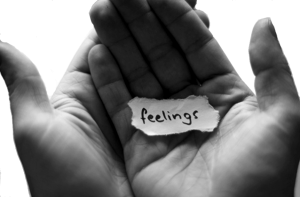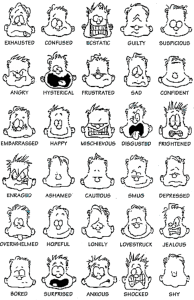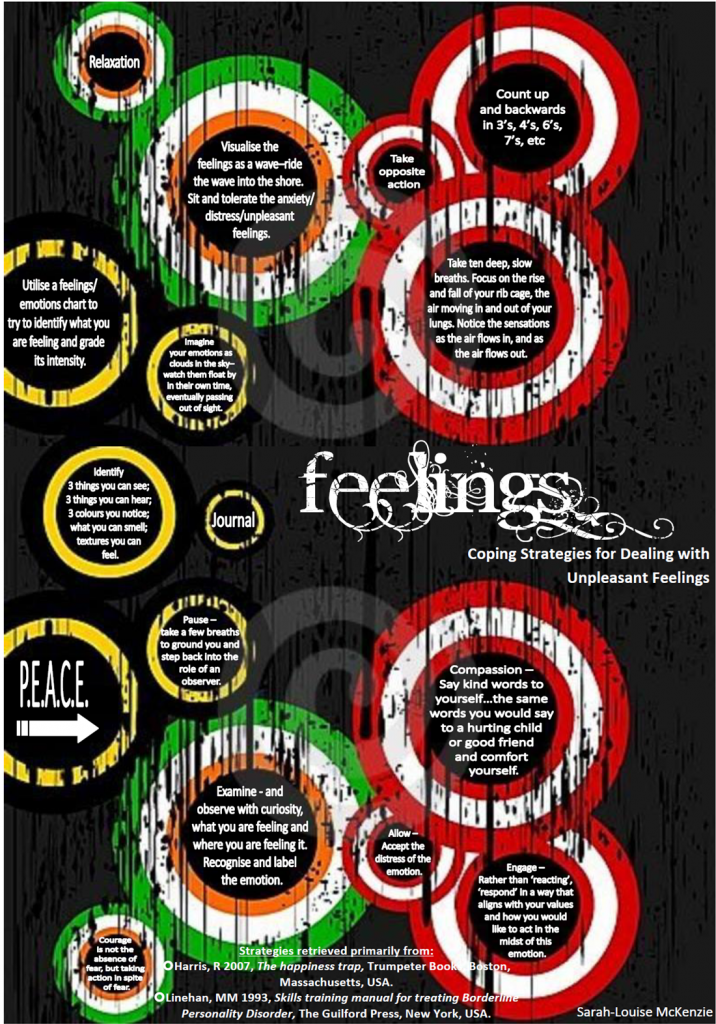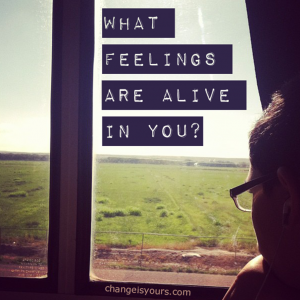 I started writing this section on feelings numerous times, each time approaching it from a different angle. I wasn’t, and still am not, sure what will be most beneficial for me to share with you. I don’t know how to make this section flow smoothly…possibly because it’s an area that I am still exploring, developing, and healing in. But, rather than becoming paralysed by indecision and writing nothing, I have decided to jot down my thoughts in more of a blog style, knowing that I can come back to edit this section over time.
I started writing this section on feelings numerous times, each time approaching it from a different angle. I wasn’t, and still am not, sure what will be most beneficial for me to share with you. I don’t know how to make this section flow smoothly…possibly because it’s an area that I am still exploring, developing, and healing in. But, rather than becoming paralysed by indecision and writing nothing, I have decided to jot down my thoughts in more of a blog style, knowing that I can come back to edit this section over time.
Why is writing about feelings a challenge for me? Well, for much of my life, I was unable to cope with the intensity of my feelings; and the expression of them in my home environment was not encouraged. Actually, the expression of emotion was often punished and phrases such as ‘Stop crying or I’ll give you something to really cry about’ were frequently heard. I was an incredibly sensitive child, but that sensitivity was ridiculed, shamed, abused, and belittled. I learnt that being sensitive was a negative thing that should be driven out of me, so as a measure of self-protection, I learnt to numb and to ignore my feelings. One of the ways I did this was through my eating disorder, as one of the effects of starvation, was that my emotions seemed to shut down and I no longer felt the intense feelings that previously overwhelmed me. Yes, I felt the physical pain and sickness my body endured from the effects of the eating disorder, but the more I denied even these physical sensations, the stronger I believed I was (when in fact, I wasn’t becoming stronger, I was becoming sicker!) I rapidly lost touch with what I felt, both internally and externally, essentially developing emotional leprosy.
Leprosy is a disease, which among other things, often damages the sensory nerves. Through loss of feeling and pain, those with leprosy may repeatedly injure their extremities during basic daily activities, resulting in the eventual amputation of fingers, toes, hands and feet.  We learn through physical sensations, what is helpful and harmful, what is healing and hazardous. For example, when your hand comes in contact with a stove top, you quickly remove it as the painful burn serves as a reminder that it is dangerous to be in such close contact with this source of heat. That searing pain, though unpleasant, has no moral value and is actually essential for leading a healthy life. Without that pain, serious injury or death would occur. Similarly, our emotions are like signposts – they let us know what is really going on. Dulling, supressing or ignoring our feelings, though seemingly an effective strategy to cope with the pain and unpleasantness of them, eventually leads to greater harm. Furthermore, it is nigh impossible to block just the unpleasant feelings without also numbing the ‘positive’ and pleasant ones also. Feelings are what bring colour and life to our existence. They are what separate us from robots and machines. They allow us to interact and connect, to love and be loved, to be creative, to know ourselves, and to be real.
We learn through physical sensations, what is helpful and harmful, what is healing and hazardous. For example, when your hand comes in contact with a stove top, you quickly remove it as the painful burn serves as a reminder that it is dangerous to be in such close contact with this source of heat. That searing pain, though unpleasant, has no moral value and is actually essential for leading a healthy life. Without that pain, serious injury or death would occur. Similarly, our emotions are like signposts – they let us know what is really going on. Dulling, supressing or ignoring our feelings, though seemingly an effective strategy to cope with the pain and unpleasantness of them, eventually leads to greater harm. Furthermore, it is nigh impossible to block just the unpleasant feelings without also numbing the ‘positive’ and pleasant ones also. Feelings are what bring colour and life to our existence. They are what separate us from robots and machines. They allow us to interact and connect, to love and be loved, to be creative, to know ourselves, and to be real.
 How do I begin to identify my feelings? This has been a long-term struggle, and over the years I have utilised various ‘feelings charts’ such as the one to the left with the expressive faces; the Feelings Inventory produced by the Center for Nonviolent Communication (CNVC); and Pleasant and Unpleasant Feelings. Whenever I struggle to identify that which I feel, I pull the lists out and am able to begin to put words to those emotions, and therefore articulate them to others. The CNVC note that their list (accessible here as a pdf and listed at the bottom of this page) is neither exhaustive nor definitive, and have separated the list into two parts: 1. Feelings we may have when our needs are being met; and 2. Feelings we may have when our needs are not being met. I have found this useful, as I am able to use the list to identify what I am feeling, and then perhaps identify what my need might be, and therefore begin to explore ways of ensuring that need is met. The CNVC Needs and Feelings App has also been really beneficial in this process and is easily accessible as I am never without my phone.
How do I begin to identify my feelings? This has been a long-term struggle, and over the years I have utilised various ‘feelings charts’ such as the one to the left with the expressive faces; the Feelings Inventory produced by the Center for Nonviolent Communication (CNVC); and Pleasant and Unpleasant Feelings. Whenever I struggle to identify that which I feel, I pull the lists out and am able to begin to put words to those emotions, and therefore articulate them to others. The CNVC note that their list (accessible here as a pdf and listed at the bottom of this page) is neither exhaustive nor definitive, and have separated the list into two parts: 1. Feelings we may have when our needs are being met; and 2. Feelings we may have when our needs are not being met. I have found this useful, as I am able to use the list to identify what I am feeling, and then perhaps identify what my need might be, and therefore begin to explore ways of ensuring that need is met. The CNVC Needs and Feelings App has also been really beneficial in this process and is easily accessible as I am never without my phone.
It’s all very well to have a list of words and try match them to physical and emotional sensations I might be experiencing, but what if I genuinely have NO idea what I’m even feeling? This is something that my therapist at Isis – the Eating Issues Centre Inc has worked with me on for several years. One of the activities she has often helped me to engage in is the body scan. Kali Munro provides a great overview of how you might go about this:
You can get to know your feelings simply by sitting quietly with your eyes closed or looking downward, and tuning inward. Shifting your attention inward helps you to sense what is going on inside of you. We can get so caught up in what we’re doing, what we’re talking about, or what other people are doing, that we forget to notice ourselves.
If, when you tune inward, you don’t notice anything, try doing a body scan. Lie down comfortably and take the time to notice how you feel in different areas of your body. Start with your head, and work your way down to your toes, or focus on the areas that most draw your attention. Notice how you feel physically in each area of your body. Do you notice any tension, cramping, numbness, or anything else?
Notice what, if anything, comes to your mind when you focus on each area of your body. For example, does a memory come to mind, a thought, an image, an emotion? Just notice what comes to you without judging or thinking about it, and then move on to the next area of your body. Try not to analyze what comes up, because that will take you out of your body and your emotions.
Some people find that by noticing the natural rhythm of their breath, they feel more tuned into their body and emotions, and some people find that doing this triggers panic and fear. If it’s comfortable for you, notice how your body rises and falls with your breath. Observing your breath can not only help you to tune inward, but can also help you to unwind.
Taking time to tune into yourself every day goes a long way toward helping you to know how you feel. You can do this almost anywhere, including sitting on the bus, waiting for the light to turn green, sitting in a traffic jam, sitting on the toilet, and so on.
This is something I struggled to do initially, as it left me feeling quite vulnerable and raw, but in the safety of my therapist’s office, with her support and compassion, I was able to participate in this process and found it incredibly beneficial. If exploring your feelings seems quite scary to do on your own, I encourage you to begin to do so with a counsellor or psychologist who is skilled to walk you through the process and can help you to tolerate any distress that may arise. Check out the Get Help section for a list of qualified therapists.
The Centre for Clinical Interventions has 4 great modules on Facing Your Feelings which can be accessed by clicking on each of the module headings below:
- Facing Your Feelings: Understanding Distress Tolerance
- Facing Your Feelings: Accepting Distress
- Facing Your Feelings: Improving Distress
- Facing Your Feelings: Tolerating Distress
 When I began to experience a range of feelings again, it was often quite overwhelming. My case manager helped me to identify strategies that would help me tolerate the unpleasant feelings, rather than continue to ignore or supress them. I created a poster outlining the various strategies, which can be accessed as a pdf here. Some of these strategies include:
When I began to experience a range of feelings again, it was often quite overwhelming. My case manager helped me to identify strategies that would help me tolerate the unpleasant feelings, rather than continue to ignore or supress them. I created a poster outlining the various strategies, which can be accessed as a pdf here. Some of these strategies include:
- Imagining my emotions as clouds in the sky – watch them float by in their own time, eventually passing out of sight.
- Take 10 deep, slow breaths. Focus on the rise and fall of my ribcage, the air moving in and out of my lungs. Notice the sensations as the air flows in, and as the air flows out.
- Utilise a feelings/emotions chart to try to identify what I am feeling and grade its intensity.
- Visualise the feelings as a wave – ride the wave into the shore. Sit and tolerate the anxiety/distress/unpleasant feelings.
- Take opposite action.
- Count up and backwards in 3’s, 4’s, 6’s, 7’s, etc.
- Engage in a relaxation activity.
- Identify 3 things I can see, 3 things I can hear, 3 colours I notice, what I can smell, and textures I can feel.
- Journal
- P.E.A.C.E. – Pause – take a few breaths to ground me and take me back into the role of an observer; Examine – and observe with curiosity what I am feeling and where I am feeling it. Recognise and label the emotion. Allow – accept the distress of the emotion. Compassion – say kind words to myself…the same words I would say to a hurting child or good friend and comfort myself. Engage – rather than ‘reacting’, ‘respond’ in a way that aligns with my values and how I would like to act in the midst of this emotion.
Strategies retrieved primarily from:
Harris, R 2007, The happiness trap, Trumpeter Books, Boston, Massachusetts, USA.
Linehan, MM 1993, Skills training manual for treating Borderline Personality Disorder, The Guilford Press, New York, USA.
Although I have made great progress in being able to identify my feelings and I am actively learning to tolerate distress, it is still easier for me to keep feelings in the realm of nouns rather than adjectives. What do I mean by that? It is easier for me to talk for example, about grief and sorrow, than about feeling sad or powerless.  It allows me to disengage from what I am feeling and just talk about it as though it were a story about anyone, refraining from connecting with the actual emotional experience. It’s less painful for me to philosophise about my problems, and to discuss them as though they are ‘out there’ and don’t really belong to me, than for me to get in touch with and fully experience the related emotions. Unfortunately in doing so, I rarely feel better or reach a resolution. However, if I get in touch with my feelings, own them, and experience them fully, I usually experience an emotional cathartic release, am then able to respond in ways that are congruent with my values and beliefs, and am able to move forward. As I continue to navigate these previously unchartered waters of feelings, I will endeavour to update this section or blog about it where relevant. I no longer want to reject this part of me, but am working towards embracing all of me. It is definitely an area worth exploring and I encourage you to get support to embrace your own feelings and the fullness and richness of life they afford.
It allows me to disengage from what I am feeling and just talk about it as though it were a story about anyone, refraining from connecting with the actual emotional experience. It’s less painful for me to philosophise about my problems, and to discuss them as though they are ‘out there’ and don’t really belong to me, than for me to get in touch with and fully experience the related emotions. Unfortunately in doing so, I rarely feel better or reach a resolution. However, if I get in touch with my feelings, own them, and experience them fully, I usually experience an emotional cathartic release, am then able to respond in ways that are congruent with my values and beliefs, and am able to move forward. As I continue to navigate these previously unchartered waters of feelings, I will endeavour to update this section or blog about it where relevant. I no longer want to reject this part of me, but am working towards embracing all of me. It is definitely an area worth exploring and I encourage you to get support to embrace your own feelings and the fullness and richness of life they afford.
Feelings Inventory by the CNVC
Feelings when your needs are satisfied
Affectionate
› compassionate › friendly › loving › open hearted › sympathetic › tender › warm
Engaged
› absorbed › alert › curious › engrossed › enchanted › entranced › fascinated › interested › intrigued › involved › spellbound
› stimulated
Hopeful
› expectant › encouraged › optimistic
Confident
› empowered › open › proud › safe › secure
Excited
› amazed › animated › ardent › aroused › astonished › dazzled › eager › energetic › enthusiastic › giddy › invigorated › lively
› passionate › surprised › vibrant
Grateful
› appreciative › moved › thankful › touched
Inspired
› amazed › awed › wonder
Joyful
› amused › delighted › glad › happy › jubilant › pleased › tickled
Exhilarated
› blissful › ecstatic › elated › enthralled › exuberant › radiant › rapturous › thrilled
Peaceful
› calm › clear headed › comfortable › centered › content › equanimous › fulfilled › mellow › quiet › relaxed › relieved › satisfied
› serene › still › tranquil › trusting
Refreshed
› enlivened › rejuvenated › renewed › rested › restored › revived
Feelings when your needs are not satisfied
Afraid
› apprehensive › dread › foreboding › frightened › mistrustful › panicked › petrified › scared › suspicious › terrified › wary
› worried
Annoyed
› aggravated › dismayed › disgruntled › displeased › exasperated › frustrated › impatient › irritated › irked
Angry
› enraged › furious › incensed › indignant › irate › livid › outraged › resentful
Aversion
› animosity › appalled › contempt › disgusted › dislike › hate › horrified › hostile › repulsed
Confused
› ambivalent › baffled › bewildered › dazed › hesitant › lost › mystified › perplexed › puzzled › torn
Disconnected
› alienated › aloof › apathetic › bored › cold › detached › distant › distracted › indifferent › numb › removed › uninterested
› withdrawn
Disquiet
› agitated › alarmed › discombobulated › disconcerted › disturbed › perturbed › rattled › restless › shocked › startled › surprised
› troubled › turbulent › turmoil › uncomfortable › uneasy › unnerved › unsettled › upset
Embarrassed
› ashamed › chagrined › flustered › guilty › mortified › self-conscious
Fatigue
› beat › burnt out › depleted › exhausted › lethargic › listless › sleepy › tired › weary › worn out
Pain
› agony › anguished › bereaved › devastated › grief › heartbroken › hurt › lonely › miserable › regretful › remorseful
Sad
› depressed › dejected › despair › despondent › disappointed › discouraged › disheartened › forlorn › gloomy › heavy hearted
› hopeless › melancholy › unhappy › wretched
Tense
› anxious › cranky › distressed › distraught › edgy › fidgety › frazzled › irritable › jittery › nervous › overwhelmed › restless
› stressed out
Vulnerable
› fragile › guarded › helpless › insecure › leery › reserved › sensitive › shaky
Yearning
› envious › jealous › longing › nostalgic › pining › wistful
(c) 2005 by Center for Nonviolent Communication
Website: www.cnvc.org Email: [email protected]
Phone: +1.505.244.4041